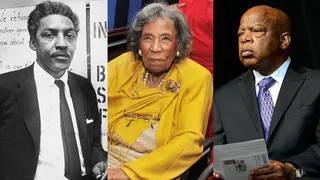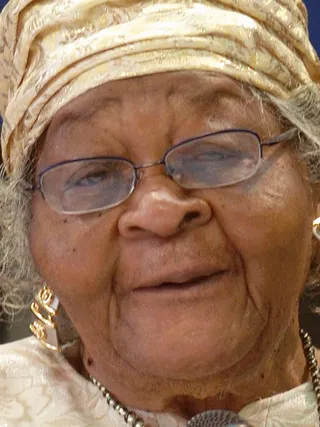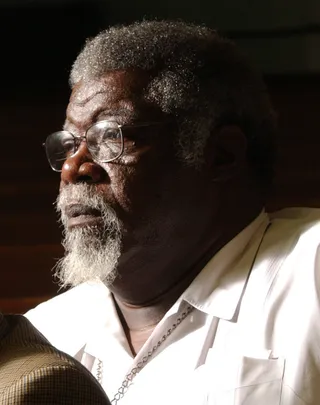Freedom Fighters: Activists Behind the Selma Marches
The courageous people who played a role in the movement.

1 / 16
Remembering Selma at 50 - Thousands will gather to honor the hard work of the courageous individuals who organized and walked from Selma to Montgomery for its 50th anniversary this weekend. BET.com looks back at the freedom fighters who played a role in the movement that led to the passing of the Voting Rights Act of 1965. — Natelege Whaley (Photos from left: Patrick A. Burns/New York Times Co./Getty Images, Stephen Lovekin/Getty Images, Riccardo S. Savi/Getty Images for U.S. Postal Service)
Photo By Photos from left: Patrick A. Burns/New York Times Co./Getty Images

2 / 16
Jimmie Lee Jackson - The death of Jimmie Lee Jackson was one of the catalysts for the 54-mile march from Selma, Alabama, to the state capitol of Montgomery. He was shot three weeks prior by a state trooper in Marion while trying to protect his mother at a civil rights demonstration. He died from an infectious wound from the shooting at the age of 26.(Photo: public domain)

3 / 16
James Bevel - James Bevel spoke into existence the march from Selma to Montgomery while preaching at the memorial service for Jimmie Lee Jackson, who was shot by Alabama state troopers during a protest. "We must go to Montgomery and see the king!" Bevel shouted. This moment was the beginning of three marches in the voting rights movement. Bevel later outlined voting rights legislation with President Lyndon B. Johnson. (Photo: Rich Lipski/The Washington Post/Getty Images)

4 / 16
Andrew Young - Andrew Young, one of the country's most prominent African-American politicians, was a close aid to Martin Luther King Jr. during the civil rights movement. As a pastor in Georgia, Young began organizing voter registration drives. He later joined the Southern Christian Leadership Conference (SCLC) and organized drives in Selma and Birmingham, Alabama. Young was also involved with creating citizenship schools that taught many young Blacks about non-violent resistance. Young went on to serve in Congress and was an ambassador to the United Nations. He was later elected as mayor of Atlanta in 1981. (Photo: Dennis Brack-Pool/Getty Images)

5 / 16
Hosea Williams - A native of Tallahassee, Florida, Hosea Williams began his road to activism when he joined the Savannah chapter of the NAACP after a life-threatening experience when he used a whites-only water fountain. Williams later joined the Southern Christian Leadership Conference in 1964 and was part of leading the March to Montgomery on Bloody Sunday. Later on, Williams was appointed executive director of the SCLC and was with King when he was assassinated. Williams continued his work as a philanthropist and activist in the fight against hunger and for human rights until his death in November 2000. (Source: Biography)(Photo: Bettmann/CORBIS)
ADVERTISEMENT

6 / 16
Bayard Rustin - The late Bayard Rustin was the innovative mind behind organizing non-violent protests and brought this knowledge to his work with Martin Luther King Jr. as one of his closest advisers. Rustin worked with King beginning in 1955 and assisted him with the Montgomery bus boycott before organizing the March on Washington. He combined the Quaker religion, which his grandmother practiced, Gandhi's non-violence techniques and socialism teachings of A. Phillip Randolph as his own philosophy. Rustin died at the age of 75 in 1987. Rustin, who was openly gay, also fought for the rights of individuals of the LGBT community up until his death. (Photo: Allan Baum/New York Times Co./Getty Images)

7 / 16
Sheyann Webb - At the age of 8, Sheyann Webb-Christburg was one of the youngest activists to attempt to march across Selma's Edmund Pettus Bridge on what became known as Bloody Sunday in 1965. When demonstrators reached the end of the bridge, they were met by police who began blowing tear gas at the crowd. Webb was brought to safety by activist Hosea Williams and ran home to safety. Webb continued to share her story by co-authoring Selma, Lord, Selma. (Source: Biography) (Photo: Sheyann Webb Christburg via SWG)

8 / 16
Rep. John Lewis - Rep. John Lewis, D-Ga., a key figure of the civil rights movement, was one of many 600 demonstrators who were beat on Bloody Sunday after organizing the historic march for voting rights. His skull was fractured by Alabama State Troopers. At the age of 23, he was the main speaker at the March on Washington in 1963 and was the Chairman of the Student Nonviolent Coordinating Committee from 1963 to 1966. (Photo: Bill Clark/CQ Roll Call)

9 / 16
Martin Luther King Jr. - Martin Luther King Jr.'s leadership brought attention to Selma during the marches of 1965, eventually leading to the passing of the Voting Rights Act that year. As the leader of the Southern Christian Leadership Council (SCLC), King put Selma at the center of the voter registration campaign since Alabama had largely been against Blacks voting and knew that the backlash would be enough to call national attention to their civil rights efforts. (Photo: Reg Lancaster/Express/Getty Images)

10 / 16
Diane Nash - As a student at Fisk University, Diane Nash was one of the founding members of the Student Nonviolent Coordinating Committee in April 1960. She also led the Nashville Freedom Riders to Alabama. She was a key figure in the voting rights campaign of 1965 and continued her work in the fight for human rights in her native Chicago. (Photo: Leigh Vogel/Getty Images)
ADVERTISEMENT

11 / 16
C.T. Vivian - Another individual who put their life on the line during the Selma protests was Cordy Tindell (C.T.) Vivian, who was part of the executive staff of SCLC as the Director of Affiliates at the time. Cameras recorded a sheriff striking Vivian as he led a group to a Selma courthouse. These images only increased support for the people organizing for voting rights. President Obama presented Vivian with the Presidential Medal of Freedom in 2013. (Photo: MANDEL NGAN/AFP/Getty Images)

12 / 16
Amelia Boynton - Photos of the suffering Amelia Boynton endured on Bloody Sunday after police officers beat her were captured and printed in newspapers across the country, shedding light on the cruelty in Selma in 1965. Police brutality that day left Boynton and 600 other protesters unconscious. Boynton was honored this year for her courageousness at President Obama's State of the Union Address in 2015. At the age of 103, she is one of the oldest surviving participants of the civil rights movement. (Photo: Marc Bryan-Brown/WireImage)

13 / 16
James Forman - Not everyone who was involved in the Selma demonstrations believed in taking a passive approach to fighting the plight of African-Americans. SNCC leader James Forman had been against King's march to Montgomery and believed in taking more aggressive actions. He encouraged local leaders in Montgomery to be vocal in expressing their disgust with the way African-Americans were being treated. He promoted a "revolutionary Black nationalist consciousness" as he continued working with SNCC and the Black Panther Party into the 1960s. In 1969, he began calling for reparations for Black Americans.(Photo: Bettmann/CORBIS)

14 / 16
Annie Lee Cooper - Annie Lee Cooper became known worldwide in 1965 when she punched Sheriff Jim Clark after standing in line for hours to register to vote. She was arrested and detained for several hours. Cooper died in 2010 at the age of 100. (Photo: Advertiser file)
Photo By Photo: Advertiser file

15 / 16
James Orange - James Orange was an aide to Martin Luther King Jr. during the civil rights movement. His arrest for organizing voting rights drive in Alabama in 1965 is one of the catalysts for the Selma-to-Montgomery march. (Photo: AP Photo/Atlanta Journal-Constitution, Renee' Hannans)
Photo By Photo: AP Photo/Atlanta Journal-Constitution
